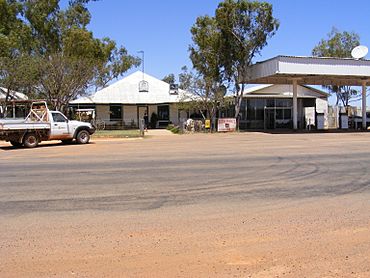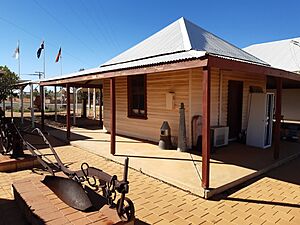Gascoyne Junction, Western Australia facts for kids
Quick facts for kids Gascoyne JunctionWestern Australia |
|
|---|---|

The Gascoyne Junction Hotel in 2007, destroyed in the 2010 floods
|
|
| Established | 1897 |
| Postcode(s) | 6705 |
| Elevation | 144 m (472 ft) |
| Area | [convert: needs a number] |
| Location | |
| LGA(s) | Shire of Upper Gascoyne |
| State electorate(s) | North West |
| Federal Division(s) | Durack |
Gascoyne Junction is a small town in Western Australia. It's located inland from Carnarvon, right where the Gascoyne River and Lyons River meet. In 2006, about 149 people lived there.
Contents
History of Gascoyne Junction
The town gets its name because it's at the "junction" (meeting point) of the Gascoyne and Lyons Rivers. An explorer named Lieutenant George Grey named the Gascoyne River in 1839. He named it after his friend, Captain J. Gascoyne.
Around 1897, a police station was built in the area. Settlers then asked the government to officially create a town. By 1909, a general store and other buildings were already there on private land. In 1912, the government finally agreed. They named the town "Killili." This was an Aboriginal word meaning "bullrush."
For many years, the police station, a local council office (called a "road board"), and a hotel were the only main buildings. In 1938, the local council complained about the name "Killili." They said everyone called the place "Gascoyne Junction" or "The Junction." They asked for the name to be changed. So, in 1939, the name was officially changed to Gascoyne Junction.
The old local council office is now a heritage-listed building. It was used for meetings and even as the first school in the area from 1960 to 1965. Since the late 1990s, it has been a museum. The number of people living in the town has stayed about the same since the 1950s.
Gascoyne Junction Today
Gascoyne Junction is now a hub for different industries. These include mining, farming, and producing fine wool from merino sheep. It's also a starting point for visiting nearby places. These include Mount Augustus National Park and Kennedy Range National Park.
The town has the Shire of Upper Gascoyne Council Office. There's also the Junction Pub and Tourist Park. You can find the Gascoyne Junction Community Resource Centre and Visitor Information Centre there too. This centre helps with Australia Post services. It also works with the Western Australia Department of Transport and Services Australia. It even has a local library.
The Junction Pub & Tourist Park offers different types of places to stay. It has a pub and a roadhouse where you can get fuel. Federation Park has picnic spots and a playground with BBQ facilities. A new Visitor Stop is planned for late 2021. It will welcome visitors and include an outdoor museum and amphitheatre.
In the 2016 Census, Gascoyne Junction was reported as a place where many people did not state a religion. About 66.5 percent of the population said they had no religion.
Transport and Services
Horizon Power provides electricity to the town. They run a diesel power station there. The town gets its water from underground bores. The Water Corporation treats this water.
The Carnarvon–Mullewa Road goes through Gascoyne Junction. The part of the road between Carnarvon and Gascoyne Junction is now sealed. A special event was held on May 20, 2011, to celebrate the completion of the last section. Australia Post delivers mail to the area using private companies. These companies also deliver fuel and other goods.
Education in Gascoyne Junction
A new Remote Community School opened in 2005. It teaches students from kindergarten all the way to year 12. High school and some college-level classes (called TAFE) are offered through the School of Isolated and Distance Education. This new school replaced an older one that started in 1960. Students have also used the Carnarvon School of the Air program in the past. Many students at the school are of Indigenous background.
The closest TAFE college is in Carnarvon. University courses are available through Carnarvon High School via Open Universities Australia. Some Curtin University courses are also offered through Pilbara TAFE in Karratha and Port Hedland.
2010 Floods
In late December 2010, the Gascoyne River flooded. People in Gascoyne Junction had to leave their homes. This big flood destroyed the town's original pub, The Junction Hotel. This building was first built in 1906 as a general store.
Climate in Gascoyne Junction
Gascoyne Junction has a hot desert climate. This means it has very hot summers and mild winters. The town holds the Australian record for the hottest Christmas Day. On Christmas Day in 1997, the temperature reached 48.3 °C (118.9 °F).
| Month | Jan | Feb | Mar | Apr | May | Jun | Jul | Aug | Sep | Oct | Nov | Dec | Year |
|---|---|---|---|---|---|---|---|---|---|---|---|---|---|
| Record high °C (°F) | 48.6 (119.5) |
48.8 (119.8) |
46.5 (115.7) |
44.2 (111.6) |
38.5 (101.3) |
30.8 (87.4) |
32.1 (89.8) |
36.2 (97.2) |
39.6 (103.3) |
42.5 (108.5) |
45.0 (113.0) |
48.3 (118.9) |
48.8 (119.8) |
| Mean daily maximum °C (°F) | 40.7 (105.3) |
39.8 (103.6) |
37.5 (99.5) |
32.9 (91.2) |
27.7 (81.9) |
23.8 (74.8) |
23.1 (73.6) |
24.9 (76.8) |
28.3 (82.9) |
32.4 (90.3) |
35.3 (95.5) |
38.7 (101.7) |
32.1 (89.8) |
| Mean daily minimum °C (°F) | 23.9 (75.0) |
24.4 (75.9) |
22.5 (72.5) |
18.7 (65.7) |
13.8 (56.8) |
10.5 (50.9) |
9.5 (49.1) |
10.0 (50.0) |
12.0 (53.6) |
15.5 (59.9) |
18.1 (64.6) |
21.3 (70.3) |
16.7 (62.0) |
| Record low °C (°F) | 15.5 (59.9) |
15.6 (60.1) |
13.0 (55.4) |
8.3 (46.9) |
3.9 (39.0) |
2.4 (36.3) |
1.4 (34.5) |
1.3 (34.3) |
4.4 (39.9) |
6.1 (43.0) |
8.9 (48.0) |
14.0 (57.2) |
1.3 (34.3) |
| Average rainfall mm (inches) | 23.7 (0.93) |
29.1 (1.15) |
30.2 (1.19) |
14.4 (0.57) |
27.2 (1.07) |
31.5 (1.24) |
27.0 (1.06) |
11.9 (0.47) |
3.0 (0.12) |
4.5 (0.18) |
3.5 (0.14) |
4.2 (0.17) |
210.2 (8.29) |
| Average rainy days | 2.3 | 2.7 | 2.2 | 1.6 | 2.8 | 3.6 | 3.3 | 2.1 | 0.7 | 0.7 | 0.6 | 0.6 | 23.2 |
| Average relative humidity (%) (at 3pm) | 20 | 24 | 24 | 29 | 34 | 42 | 40 | 33 | 25 | 21 | 20 | 18 | 28 |
| Source: Bureau of Meteorology | |||||||||||||



